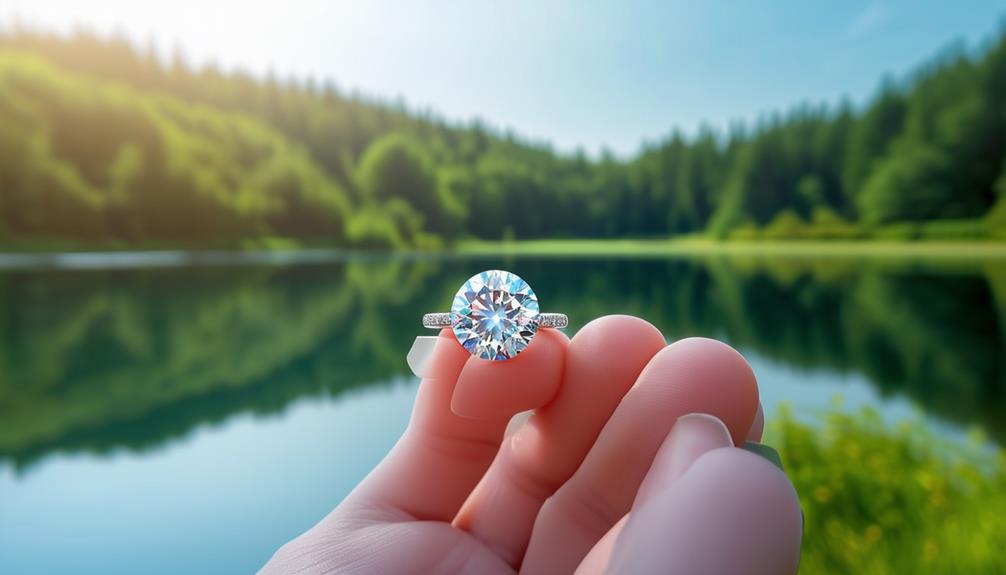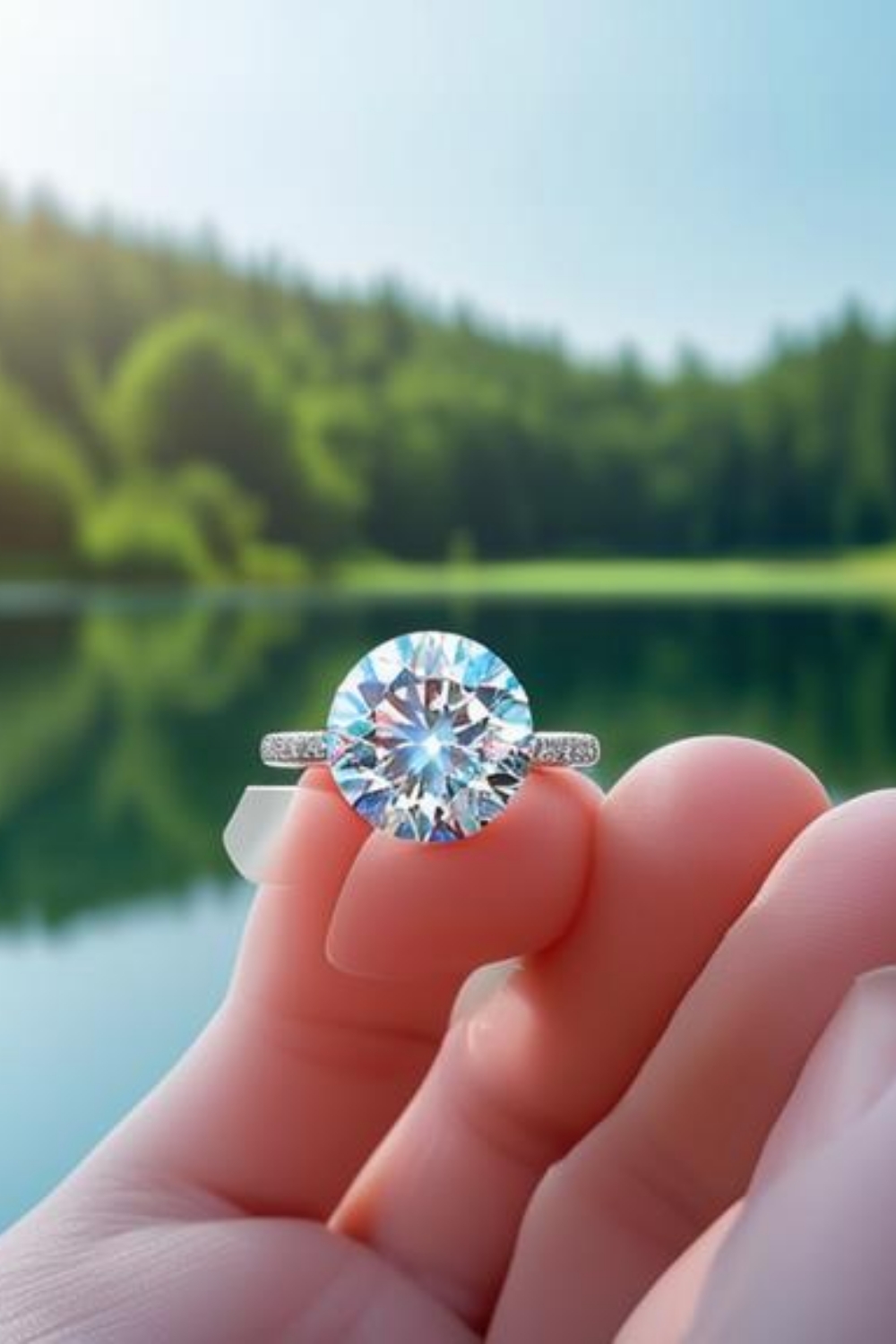Article Contents
Cultivated diamonds represent a significant advancement in sustainable luxury. These gemstones offer a lower carbon footprint than traditional mining, with potential integration of renewable energy sources further enhancing their environmental benefits.
They also significantly reduce water usage, requiring only 18 gallons per carat, compared to the 126 gallons used in conventional mining processes. This demonstrates a strong commitment to water conservation.
Additionally, cultivated diamonds require minimal land use and prevent extensive land disruption, aiding in the preservation of natural habitats and protecting biodiversity.
This combination of luxury and environmental responsibility exemplifies the potential for harmonising fashion with conservation efforts.
Key Points
- Lab-grown diamonds substantially reduce carbon emissions due to their energy-efficient production methods.
- Cultured diamonds utilise significantly less water, requiring only 18 gallons per carat, whereas traditional mining demands 126 gallons per carat.
- The manufacturing of lab-grown diamonds results in minimal land disturbance, aiding in the preservation of ecosystems and biodiversity.
- The use of renewable energy in the production of cultured diamonds further bolsters their environmental sustainability.
- By offering an eco-friendly alternative, cultured diamonds promote responsible consumption by combining luxury with environmental stewardship.
Reducing Carbon Emissions
Lab-grown diamonds significantly reduce our carbon emissions by using production processes that are less energy-intensive than traditional mining. These diamonds promote sustainable practices by potentially utilising renewable energy sources such as solar or wind power, thereby enhancing their environmental credentials. Opting for these energy sources during the production process demonstrates responsible consumption and contributes to the fight against climate change.
Furthermore, choosing lab-grown diamonds helps to decrease greenhouse gas emissions, representing a significant step towards sustainability in the jewellery industry. This choice not only shows a dedication to environmental protection but also aligns with modern luxury values, where elegance and ecological responsibility coexist.
Therefore, lab-grown diamonds strike a balance between meeting human desires for luxury and preserving the planet's health, making them a responsible option for environmentally conscious consumers.
Conserving Water Resources
In addition to reducing carbon emissions, lab-grown diamonds make a significant contribution to conserving water resources compared to traditional diamond mining. Traditional mining uses around 126 gallons of water per carat, whereas lab-grown diamonds only require 18 gallons per carat. This substantial decrease demonstrates the potential for considerable water conservation and encourages sustainable practices in the jewellery industry.
| Water Usage Comparison (gallons per carat) | Impact on Water Conservation |
|---|---|
| Traditional Diamond Mining: 126 | High Water Footprint |
| Lab-Grown Diamonds: 18 | Reduced Water Footprint |
| Savings: 108 | Enhanced Sustainability |
| Choice: Traditional Mining | Stresses water resources |
| Choice: Lab-Grown Diamonds | Supports sustainable water use |
Opting for lab-grown diamonds can significantly decrease the water footprint of diamond production, promoting more sustainable use of resources in the jewellery industry.
Preserving Natural Habitats
Choosing cultured diamonds significantly enhances the preservation of natural habitats by minimising land disruption compared to traditional diamond mining. Traditional mining methods require extensive land excavation, leading to deforestation, soil erosion, and wildlife displacement, which in turn reduces biodiversity and disrupts ecosystems.
Lab-grown diamonds, however, are produced in controlled environments that require minimal land use, thus helping to preserve natural habitats and maintain ecological integrity. This method reduces waste generation and limits ecosystem disruption, promoting environmental sustainability and mitigating the harmful impacts associated with mining.
Therefore, selecting cultured diamonds is a meaningful act of ecological responsibility. It reflects a commitment to both personal choice and the preservation of natural habitats, allowing them to remain undisturbed. This choice fosters a future where fashion and conservation are aligned, contributing to a legacy of respect and care for the planet.
Frequently Asked Questions
What are 3 benefits of having synthetic diamonds?
Three key advantages of synthetic diamonds are their reduced environmental impact, lower resource usage, and their contribution to innovation in the jewellery industry. These diamonds promote sustainability, appealing to consumers who prioritise eco-friendly products.
How Do Diamonds Impact the Environment?
Diamond mining has a significant impact on the environment in the form of extensive land degradation, deforestation, and the destruction of ecosystems. It also requires a high amount of water and energy, leading to a considerable ecological footprint. This highlights the importance of investigating sustainable alternatives.
How are synthetic diamonds beneficial for the environment?
Synthetic diamonds significantly reduce carbon emissions and water usage, making them an environmentally friendly choice for consumers. Unlike conventional diamond mining, their production causes less harm to the environment and depletion of resources, which contributes positively to sustainability initiatives.
What Are the Positive Impacts of Natural Diamonds?
Natural diamonds make a big difference to local economies by creating jobs and generating income. They help with the development of communities by providing support for education, healthcare, and infrastructure projects in mining areas.
Conclusion
Cultured diamonds significantly reduce the ecological impact of diamond production by minimising carbon emissions, conserving water resources, and protecting natural habitats compared to traditional mining methods.
These lab-grown diamonds are both ethically sourced and environmentally friendly, presenting a sustainable alternative in the jewellery industry.
They align luxury with environmental responsibility, promoting a sustainable future without compromising quality or beauty.



